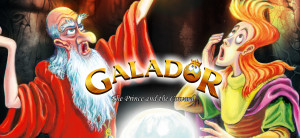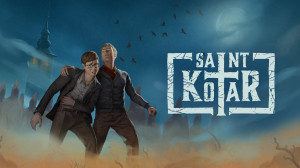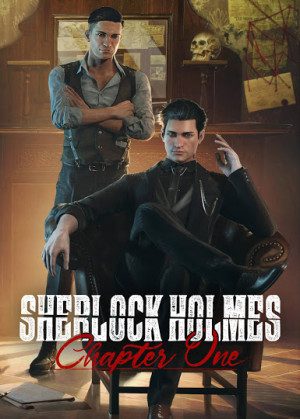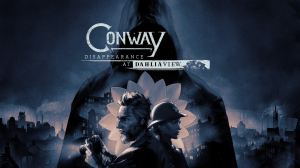Review for Hermitage: Strange Case Files
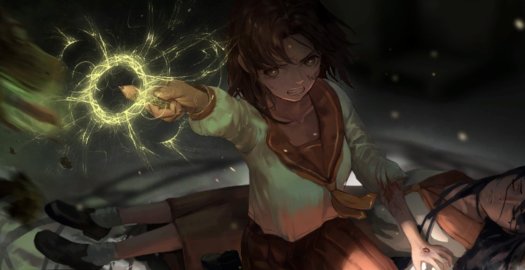
Why have Lovecraft’s tales of sci-fi horror so enduringly captured the fascination of creatives – filmmakers, authors and game developers alike? Perhaps it’s the allure of terrifying creatures and gods that are beyond description or comprehension for mere humans. As Lovecraft himself said, “The oldest and strongest emotion of mankind is fear, and the oldest and strongest kind of fear is fear of the unknown.” For decades we’ve seen a deluge of content inspired by his work, some more successful than others. Hermitage: Strange Case Files is a dark horror-mystery adventure in a visual novel-shaped package wrapped with beautifully bleak art, and thankfully I’d place it squarely in the “more successful” camp.
The story is primarily told from the perspective of a nameless Book Store Manager who loves smoking. A lot. He’s also a keen researcher of supernatural occurrences and a trained psychotherapist who runs the titular Hermitage, a place full of obscure texts (including regional folklore and religious ones). Because of the manager and its unorthodox books, it’s a magnet for customers in unusual situations.
One such client is Cecile, a student at the prestigious Phoenix High School. During the day she struggles to fit in, with her classmates being actively cruel to her, saying she should “sit here and rot. Like a mushroom.” Her sleep is plagued with nightmares, as she dreams of soldiers in droves violently snatching babies from terrified citizens; of islands ablaze, animals perishing in the flames. She wants to discover if her dreams are actually real, because while asleep she has also seen her best friend Eloise face down on the floor covered in blood and wants to make sure that never becomes a reality.
Searching for proof that these are more than just dreams, the Manager sees an incident on the news about a major road collapse, leaving a hole ten metres wide. This sounds similar to one of Cecile’s nightmares – and it just so happens to be the event that legal consultant and long-term friend Scarlet is investigating. Surely this is no coincidence. Either way, it falls to him to find out what’s causing these visions before things take a grisly turn for the worse at Cecile’s school; a journey of discovery that will bring the afflicted Cecile face to face with an ancient, otherworldly thing.
That’s just the first case of five; other puzzling occurrences to resolve include a group of visitors from Yuhoi village at the root of some seriously fishy goings on, and a spate of runaway pets. These cases stand alone but also collectively provide an overarching mystery, with recurring characters such as Neko, a teenage hacker and former friend of the Manager’s who arrives at the store with an expression that’s “a mixture of fear and nostalgia, like a traveller leaving behind his hometown, both driven yet homesick at the same time.” Another is Justin, a private detective in his twenties outfitted in a trench coat and cap, who gets pulled into the investigative team. Throw into the mix a suspicious delivery man who always just so happens to bring you rare books exactly when you need them, and a spate of unexplained large holes opening up in the ground, and there’s plenty of intriguing story to delve into.
More interesting than the human characters are the monsters you’ll meet or learn about along the way, whether an up-close encounter or a reference in one of the books in the store. Expect fish-like beings, a garghoul (a creature with the characteristics of both a horse and an insect, which “hisses like the wind and neighs like a horse at the same time”) and others that are “ten feet tall and built like tree trunks. Black tentacles squirm on top of them, and their length and flexibility are beyond words.” As the quotes probably show, the writing is competent, with vivid descriptions and no clunky English translations – the game was originally written in Chinese – though there are a few typos.
As with most visual novels, the graphics are static background images. Here the contemporary settings have a hand-painted feel, full of muted colours, usually with character portraits in the foreground depending on who’s talking at the time. Moving the mouse around does cause the image to pan just a tiny amount, which feels ever so slightly more interactive than staring at a fixed screen.
Other scenes reveal significant narrative moments, such as a shot of Cecile looking away from the camera with a collage of gossiping, mean-spirited girls surrounding her. A deliberately imprecise art style is used, with thick and bold brush strokes that are quite visually striking. There’s also a handful of particularly detailed, beautifully drawn and vibrant images to accompany the conclusions of some of the chapters. The depictions of the creatures are ghoulishly interesting, though it’s difficult to portray beasts that often are supposed to defy description. Adding to the overall style are a lot of different font types (for titles, menus, etc. but thankfully not the core text). Many have a ransom-note, higgledy-piggledy feel I found reminiscent of the Japanese RPG franchise Persona.
The characters themselves have a mature, considered manga look. Expressions of emptiness and ennui are skilfully captured, giving a melancholy air to proceedings. The closest we get to smiles are looks of quiet satisfaction or smirks. Each character has several poses, though they’re not animated. Some of the characters with more minor roles are literally just black silhouettes with chalk outlines.
Though the majority of scenes are static, there is a small amount of animation. For instance, when the protagonist is thinking, a comic book panel will open up, showing the Manager’s hand moving a lit cigarette to his mouth, smoke drifting outwards. In another scene, black smoke drifts in the background, out of which appears an undulating, terrifying creature. In another, clouds billow in the distance as something awful bursts out of a rooftop shack.
The music is also well-crafted and enjoyable. The game starts with a mellow lounge-style track that put me in mind of lazy days and chilled-out bars; not quite what I was expecting given the game’s dark themes, but not unpleasant. Another was a sax-driven tune, again a smooth, relaxing track. It’s not all serene woodwinds and sedate beats, though. As the investigation intensifies, we hear ominous bass tones layered with higher-pitched keyboard notes, creating a sense of mystery. The conclusion of the first case is accompanied by a chaotic, part-jazz, part-dance track with a frenzied beat. For all its variety, however, as the game is quite lengthy, the score can occasionally still feel a little repetitive.
There’s no voice acting but there are some audio effects, although they mainly seem limited to where they’ll have the most impact. We hear the school bell chiming, the clatters and clunks of Cecile falling over into some books in the bookstore, a knock at the door, footsteps, the whistling neigh of a beast from beyond. The text makes quiet but frequent beeps as subtitles appears on-screen; however, if you’d prefer to play without the additional noise, there’s an option to switch this off.
As you might expect for this kind of game, the interface is very simple and intuitive. A left mouse click (or enter on the keyboard) will advance the text. A hamburger menu button in the bottom right allows you to access the log (previously viewed text), switch to auto mode (meaning you’re not constantly clicking as you read), or skip (helpful if you’re replaying for a different ending, allowing you to speed through sections you’re already familiar with). Text display speed is adjustable via a slider switch – a welcome feature in a visual novel. However, it doesn’t discernibly affect the speed of auto mode, which feels too infuriatingly slow to actually use. There are plenty of manual save slots – 44 in fact – but there’s also an autosave function which saves regularly and notifies you in the top right as it’s doing so.
Up in the top left you can see whether it’s day or night, and what the date is (another Persona-esque touch). Hermitage is split up into straightforward visual novel sections interspersed with interactive scenes as you progress through the days and nights. The interactive segments involve several (labelled) hotspots popping up on screen. During the day, these take place in the bookstore. Clicking “bookshelf” lets you inspect some of the store's more curious tomes. Selecting a book allows you to read a summary of it. A number of the game’s influences are proudly on display here, with several books about Lovecraft and the Cthulhu mythos prominently arranged on the bottom shelf.
Picking “conversations” allows you to speak with whoever’s in the store at that point. Sometimes you’ll be presented with responses displayed in the form of large speech bubbles with your dialogue possibilities (which provide a flavour of how you’ll reply rather than spelling out your response word for word), as well as information about the tone (intimidating, straightforward, bluff, beat around the bush, showing you care, and so on). Although these choices are infrequent, a couple are critical as the right option will lead to a required clue, without which you’ll get a bad ending for the chapter. Other times you’ll be offered a simple list of topics to work your way through.
Selecting “thoughts” causes you to light up a cigarette and consider your next move; our protagonist will muse on the current situation, provide some analysis and sometimes give you a nudge in the right direction, such as suggesting a conversation with a customer, checking out some of the books, or stating that two particular incidents are definitely connected. The final option is “case files” that lets you review what intel you’ve picked up. As you progress, key information – and questions to get to the bottom of – will automatically be added to the case file.
At night, the Manager retires to his tiny apartment above the Hermitage, where a number of similar options await (including thoughts and case files, which function as they do in the day), one of which is “watch TV.” This is an opportunity to turn on the news for intel on anything major occurring, though there are no actual video clips, just a photorealistic still of two news anchors. Or you may just get a textual summary of a show that’s on, whether that be a wildlife documentary, a romance or a home shopping show.
The “internet” option takes you to a popular forum where you can read posts about such diverse topics as someone finding a spider in their house, a discussion about the poisoning of a Russian model, three-eyed genetically modified mosquitoes, and Lovecraft. Finally there is “relationship,” which displays a close-up of an evidence board with connections marked with string between friends and people of interest from all of your cases so far. You can zoom in to view more details about the characters involved and how they all join up, or revisit certain key sections of dialogue from your investigation.
Sometimes an event (or learning something new) will trigger a text conversation on the manager’s mobile. Though the player interaction here is mainly just to click to send, you are occasionally presented with different response options. You can review previous conversations using a curious button at the bottom left of the screen, which seems to depict one speech bubble attacking another.
When you’ve gathered enough information, either during the day or night segments, you can use the “next stage/finish work” or “end day” button in the bottom right which will move the story (and the time) onwards. It is possible to move forward with the story without having obtained all the necessary clues, meaning you’ll wind up unable to solve the case file puzzles (more on those shortly) at the end of the chapter. That said, it’s pretty simple to check all the books and forums to pick up the clues required.
Sometimes when the day moves forward, the perspective will switch to a key character such as Scarlet, Neko or Justin, who are venturing out to do some further snooping on your behalf, whether that’s in a local school, a tower block or the run-down district where bodies have gone missing. The fact that this involves them and not you (as the Manager) fits well since he’s essentially a hermit who barely ever leaves the store or his apartment. That in itself is presented as a mystery, which Hermitage addresses during its satisfying but lengthy conclusion.
At certain points you’ll be taken to the case files screen, where you need to piece clues together to answer the questions the Manager has been jotting down during the course of your investigation. This is a simple process – just drag the correct pieces of information from your notebook into the file. Get it right and the Manager will draw a conclusion that propels the story along, whether it’s exactly what Cecile’s dreams mean or finding out what happened to Eloise. Get it wrong three times and you’ll fail the puzzle, which ultimately will lead to a bad ending for that particular chapter. If you want to get a better ending before continuing to the next episode, you’ll need to load a save prior to your failed attempt. These deductive puzzles get progressively harder as the story deepens, as there are more potential clues to choose from. Probably too hard, in fact; I often found it difficult to figure out what the game was looking for based on the question posed, so these sections weren’t as fun as they could have been.
More fun are the occasional bizarre encounters. The nature of these strange cases inevitably leads to conflict, and one of our team of investigators can find themselves suddenly embroiled in a battle with a hideous monster. Thankfully (for me, anyway) there’s no need for fast reflexes as you simply need to select from pop-up labels what action to take next – which part of the creature to strike, which cosmic horror to target, whether to hide or fight. It’s a great way of adding an element of danger and horror without including actual action. You can die and need to reload a save if you make the wrong choices, but they aren’t particularly challenging if you’ve been paying attention.
Later in the game there are also a couple of sections where you’ll see the current investigator as an icon on a handheld console-style screen. These include some directional buttons below (generally north, south, east and west) that can be used to guide the character around the 2D representation of the area, providing an opportunity to more directly explore the tower block location, tracking down clues and eavesdropping through doors.
One final – somewhat frustrating – mechanic worth mentioning is where a picture of an eye appears above a person you are talking to. The objective is to click on it at the right time and select a body part to study. I never really knew what constituted the right time or the right body part, to be honest, and though I am fairly sure I got at least some of these segments wrong, there didn’t seem to be a noticeable effect on the story.
On balance, I enjoyed my time (all 25 or so hours of it) with Hermitage: Strange Case Files. Perhaps with a few simple tweaks, it could have been truly outstanding; if the deduction puzzles had been more logical they would have been far more satisfying to solve, and the body inspection mechanic seemed entirely unintuitive and unnecessary. Despite this, however, there’s enough well-written Lovecraftian plot to draw you entirely into this world plagued with mysterious phenomena, following the characters on their journey and appreciating the somewhat melancholic art and chilled beats along the way.













